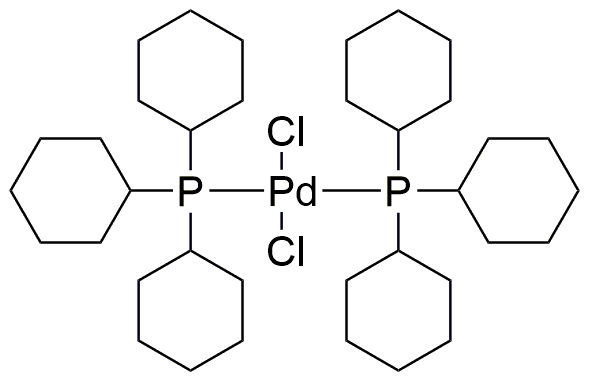Bis(tricyclohexylphosphine)palladium(II) dichloride is widely utilized in research focused on:
- Catalysis in Organic Synthesis: This compound serves as a highly effective catalyst in various cross-coupling reactions, such as Suzuki and Heck reactions, facilitating the formation of carbon-carbon bonds in organic compounds.
- Pharmaceutical Development: It plays a crucial role in the synthesis of complex pharmaceutical intermediates, enabling the efficient production of active pharmaceutical ingredients (APIs) with improved yields and purity.
- Material Science: The compound is used in the development of advanced materials, including polymers and nanomaterials, where it aids in the functionalization of surfaces and the creation of novel composite materials.
- Environmental Chemistry: It is applied in the synthesis of environmentally friendly chemicals, helping researchers develop greener processes that reduce waste and energy consumption compared to traditional methods.
- Research in Catalytic Mechanisms: Scientists utilize this compound to study catalytic mechanisms and reaction pathways, providing insights that can lead to the design of more efficient catalysts in various chemical processes.
General Information
Properties
Safety and Regulations
Applications
Bis(tricyclohexylphosphine)palladium(II) dichloride is widely utilized in research focused on:
- Catalysis in Organic Synthesis: This compound serves as a highly effective catalyst in various cross-coupling reactions, such as Suzuki and Heck reactions, facilitating the formation of carbon-carbon bonds in organic compounds.
- Pharmaceutical Development: It plays a crucial role in the synthesis of complex pharmaceutical intermediates, enabling the efficient production of active pharmaceutical ingredients (APIs) with improved yields and purity.
- Material Science: The compound is used in the development of advanced materials, including polymers and nanomaterials, where it aids in the functionalization of surfaces and the creation of novel composite materials.
- Environmental Chemistry: It is applied in the synthesis of environmentally friendly chemicals, helping researchers develop greener processes that reduce waste and energy consumption compared to traditional methods.
- Research in Catalytic Mechanisms: Scientists utilize this compound to study catalytic mechanisms and reaction pathways, providing insights that can lead to the design of more efficient catalysts in various chemical processes.
Documents
Safety Data Sheets (SDS)
The SDS provides comprehensive safety information on handling, storage, and disposal of the product.
Product Specification (PS)
The PS provides a comprehensive breakdown of the product’s properties, including chemical composition, physical state, purity, and storage requirements. It also details acceptable quality ranges and the product's intended applications.
Certificates of Analysis (COA)
Search for Certificates of Analysis (COA) by entering the products Lot Number. Lot and Batch Numbers can be found on a product’s label following the words ‘Lot’ or ‘Batch’.
Numéro de catalogue
Numéro de lot/série
Certificates Of Origin (COO)
This COO confirms the country where the product was manufactured, and also details the materials and components used in it and whether it is derived from natural, synthetic, or other specific sources. This certificate may be required for customs, trade, and regulatory compliance.
Numéro de catalogue
Numéro de lot/série
Safety Data Sheets (SDS)
The SDS provides comprehensive safety information on handling, storage, and disposal of the product.
DownloadProduct Specification (PS)
The PS provides a comprehensive breakdown of the product’s properties, including chemical composition, physical state, purity, and storage requirements. It also details acceptable quality ranges and the product's intended applications.
DownloadCertificates of Analysis (COA)
Search for Certificates of Analysis (COA) by entering the products Lot Number. Lot and Batch Numbers can be found on a product’s label following the words ‘Lot’ or ‘Batch’.
Numéro de catalogue
Numéro de lot/série
Certificates Of Origin (COO)
This COO confirms the country where the product was manufactured, and also details the materials and components used in it and whether it is derived from natural, synthetic, or other specific sources. This certificate may be required for customs, trade, and regulatory compliance.


